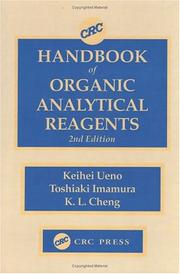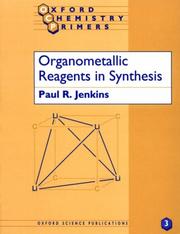| Listing 1 - 6 of 6 |
Sort by
|
Book
ISBN: 9789264070486 Year: 1992 Publisher: Paris : OECD Publishing,
Abstract | Keywords | Export | Availability | Bookmark
 Loading...
Loading...Choose an application
- Reference Manager
- EndNote
- RefWorks (Direct export to RefWorks)
This Test Guideline describes two methods for biodegradability in seawater. The shake flask method consists on dissolution of a pre-determined amount of the test substance in the test medium to yield a concentration of 5-40 mg/l dissolved organic carbon (DOC). Five flasks, at least, should be used: two for the test suspension, two for the blank and one for procedure control. The solution of the test substance in the test medium is incubated, under agitation in the dark or in diffuse light under aerobic conditions, at a fixed temperature which will normally be within the range 15-20°C. The recommended maximum test duration is about 60 days. Degradation is followed by DOC measurements (ultimate degradation) and, in some cases, by specific analysis (primary degradation). The closed bottle method consists on dissolution of a pre-determined amount of the test substance in the test medium in a concentration of usually 2-10 mg/l (one or more concentrations may be used).The solution is kept in a filled closed bottle in the dark in a constant temperature bath or enclosure controlled within a range of 15-20°C. The degradation is followed by oxygen analyses over a 28-day period but if the blank biological oxygen demand value remains within the 30 per cent limit, the test could be prolonged. Twenty-four bottles at least are used (8 for test substance, 8 for reference compound and 8 for sweater plus nutriment). All analyses are performed on duplicate bottles. Four determinations of dissolved oxygen, at least, are performed (day 0, 5, 15 and 28) using a chemical or electrochemical method.
Chemical tests and reagents --- Chemical reagents --- Reagents, Chemical --- Indicators and test-papers
Book
ISBN: 0080418643 Year: 1992 Publisher: Oxford : Pergamon,
Abstract | Keywords | Export | Availability | Bookmark
 Loading...
Loading...Choose an application
- Reference Manager
- EndNote
- RefWorks (Direct export to RefWorks)
Flotation --- Flotation reagents --- Chemical tests and reagents --- Froth flotation --- Ore-dressing --- Separation (Technology) --- Equipment and supplies
Book
ISBN: 9789264070387 Year: 1992 Publisher: Paris : OECD Publishing,
Abstract | Keywords | Export | Availability | Bookmark
 Loading...
Loading...Choose an application
- Reference Manager
- EndNote
- RefWorks (Direct export to RefWorks)
This Test Guideline describes the Zahn-Wellens/EMPA Test. It is used to determine inherent biodegradability. A mixture containing the non-volatile and water soluble test substance, mineral nutrients and a relatively large amount of activated sludge in aqueous medium is agitated and aerated at 20-25°C in the dark or in diffuse light, for up to 28 days. Blank controls, containing activated sludge and mineral nutrients but no test substance, are run in parallel. The functional capability of the activated sludge is tested using a reference compound (ethylene glycol, diethylene glycol, lauryl sulfonate or aniline). In a typical run 1 or 2 vessels for the test suspension and for the inoculum blank, 1 for procedure control are used. The biodegradation process is monitored by determination of DOC, Dissolved Organic Carbon, (or COD, Chemical Oxygen Demand) in filtered samples, taken at daily or other time intervals. It is mandatory to follow DOC in the test suspension and inoculum blanks in parallel. The ratio of eliminated DOC (or COD), corrected for the blank, after each time interval, to the initial DOC value is expressed as the percentage biodegradation at the sampling time. The percentage biodegradation is plotted against time to give the biodegradation curve. The test is considered valid if the procedural control shows the removal of the reference compound by at least 70% within 14d and if DOC (or COD) in the test suspension is removed relatively gradually over days or weeks, since this indicates biodegradation.
Chemical tests and reagents --- Chemical reagents --- Reagents, Chemical --- Indicators and test-papers
Book
ISBN: 1560815078 352728043X 1560810106 9781560810100 Year: 1992 Publisher: New York VCH
Abstract | Keywords | Export | Availability | Bookmark
 Loading...
Loading...Choose an application
- Reference Manager
- EndNote
- RefWorks (Direct export to RefWorks)
Catalysis --- Supported reagents --- Catalyse --- Supported reagents. --- Reagents, Supported --- 547-4 --- Chemical tests and reagents --- 547-4 Organic chemistry--?-4 --- Organic chemistry--?-4 --- fysicochemie --- Organic reaction mechanisms and kinetics

ISBN: 0849342872 131514056X 1351457217 9781315140568 9781351457217 9780849342875 Year: 1992 Publisher: Boca Raton, FL CRC Press
Abstract | Keywords | Export | Availability | Bookmark
 Loading...
Loading...Choose an application
- Reference Manager
- EndNote
- RefWorks (Direct export to RefWorks)
Chemical tests and reagents. --- Organic compounds. --- 547-4 --- Compounds, Organic --- Organic chemicals --- Carbon compounds --- Chemical reagents --- Reagents, Chemical --- Indicators and test-papers --- Organic reagents --- Chemie--Proeven en reagentia --- Chemische reagentia --- Chimie--Essais et reactifs --- Compounds [Organic ] --- Reactifs chimiques --- Reagents [Chemical ] --- Chemical tests and reagents --- Organic compounds

ISBN: 0198556667 0198556675 9780198556664 9780198556671 Year: 1992 Volume: 3 Publisher: Oxford : Oxford University Press,
Abstract | Keywords | Export | Availability | Bookmark
 Loading...
Loading...Choose an application
- Reference Manager
- EndNote
- RefWorks (Direct export to RefWorks)
Organometallic compounds --- Organic compounds --- Synthesis --- #WSCH:MAFO --- 547.057 --- 547-4 --- 547.057 Organic chemistry--?.057 --- Organic chemistry--?.057 --- 547-4 Organic chemistry--?-4 --- Organic chemistry--?-4 --- Metallo-organic compounds --- Metalloids, Organic --- Metalorganic compounds --- Organometalloids --- Chemistry, Organic --- Chemistry, Synthetic organic --- Organic synthesis (Chemistry) --- Synthetic organic chemistry --- Organometallic compounds. --- Synthesis. --- Organic compounds - Synthesis. --- Organic compounds - Synthesis --- CHEMICAL TESTS AND REAGENTS --- ORGANOMETALLIC COMPOUNDS --- ORGANIC COMPOUNDS --- SYNTHESIS
| Listing 1 - 6 of 6 |
Sort by
|

 Search
Search Feedback
Feedback About UniCat
About UniCat  Help
Help News
News